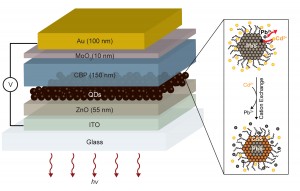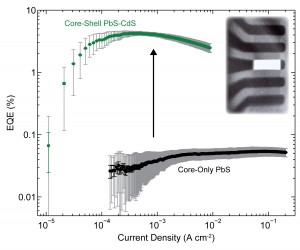High-performance Near-infrared Light-emitting Devices using Core-shell (PbS-CdS) Colloidal Quantum-dots
- Category: Electronic Devices, Materials, Nanotechnology
- Tags: geoffrey supran, vladimir bulovic
Near-infrared light sources integrated at room temperature with any planar surface could be realized by harnessing the broad spectral tunability, high brightness, and solution-processability of colloidal quantum-dots (QDs)[1]. Yet the performance of near-infrared quantum-dot light-emitting devices (NIR QD-LEDs) has remained relatively low until now[1]. Here we show that PbS-CdS core-shell QDs, synthesized via a Pb-to-Cd cation-exchange reaction[2] (Figure 1, inset), enhance the peak external quantum efficiency (EQE) of PbS core-only control devices by 50- to 100-fold, up to 4.3 ± 0.3% (Figure 2). By incorporating the core-shell QDs into the novel organic-QD-inorganic hybrid NIR QD-LED architecture depicted in Figure 1, “turn-on” voltages are lowered by 0.6 ± 0.2 V, and per-amp radiant intensities are increased by up to 150 times. Peak EQEs and power conversion efficiencies are more than double those of previous QD-LEDs emitting at wavelengths beyond 1 μm[3] and are comparable with those of commercial NIR LEDs. We demonstrate that the primary origin of the performance enhancement is passivation of PbS cores by CdS shells against in situ photoluminescence quenching, suggesting that core-shell QDs may become a mainstay of high-efficiency NIR QD-LEDs.
Electrically-driven and wavelength-selectable NIR light sources that can be deposited on any substrate and at lower cost than existing (usually epitaxially grown) NIR-emitters have the potential to enhance existing technologies and to trigger the development of new ones[1]. Beneficiaries could include optical telecommunications and computing, bio-medical imaging, on-chip bio(sensing) and spectroscopy, night-time surveillance, and other security applications.
- Figure 1: The novel organic-QD-inorganic hybrid NIR QD-LED architecture, fabricated at room temperature, employed in this work. The inset is a schematic illustration of the Pb-to-Cd cation-exchange reaction used to convert core-only PbS QDs into core-shell PbS-CdS QDs.
- Figure 2: A plot of external quantum efficiency versus current density, demonstrating the ~50- to 100-fold enhancement in QD-LED performance achieved by replacing core-only PbS QDs (black) with core-shell PbS-CdS QDs (green). The inset is a photograph of an array of five QD-LEDs taken with an infrared camera, with the middle device turned on and emitting at a center wavelength of λ=1242 nm .
- Y. Shirasaki, G. J. Supran, M. G. Bawendi, and V. Bulović, “Emergence of Colloidal Quantum-Dot Light-Emitting Technologies,” Nature Photonics, vol. 7, pp. 13-23, Jan. 2013. [↩] [↩] [↩]
- J. M. Pietryga et al., “Utilizing the lability of lead selenide to produce heterostructured nanocrystals with bright, stable infrared emission,” J. Am. Chem. Soc., vol. 130, pp. 4879-4885, Mar. 2008. [↩]
- L. Sun et al., “Bright infrared quantum-dot light-emitting diodes through inter-dot spacing control,” Nature Nanotechnology, vol. 7, pp. 369-373, May 2012. [↩]

